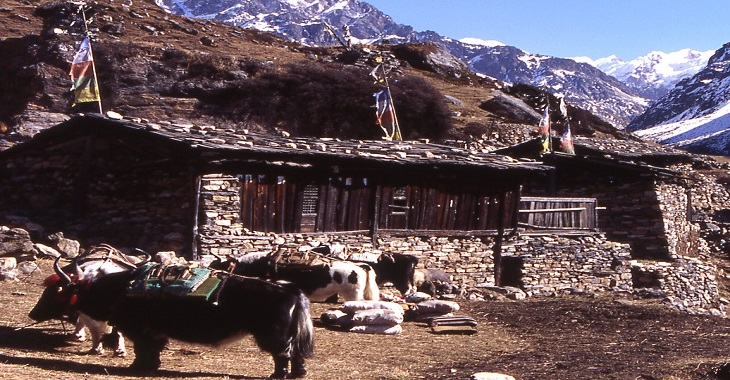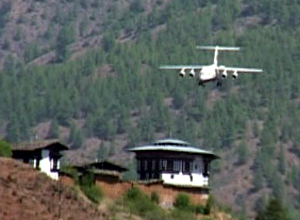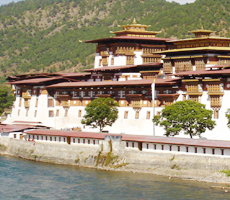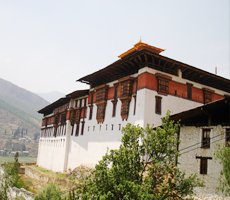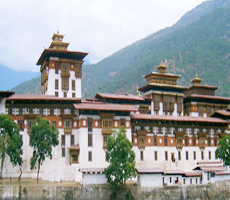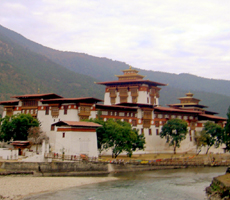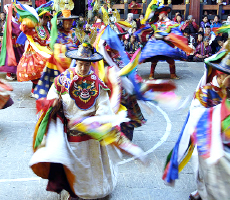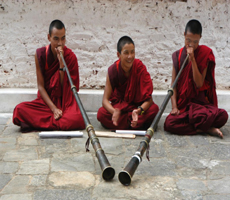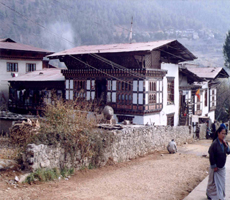WESTERN REGION
The western region comprises of the six western Districts in the country that includes Thimphu, Paro, Haa, Wangdue Phodrang, Punakha and Gasa.
In this cregions, you can attend the summer festival of Haa and delve into the wonders of the ancient living culture of the Haaps (People from Haa). The festival highlights Shamanic rituals and other folk dances. You may also enjoy the beauty of rare Himalayan flowers in bloom or take a daring trek to Nob Tsonapatra, immersing you in the interesting legends of the area.
In Thimphu you can witness the newly introduced Takin Festival, MICE & GNH conferences, meditation and wellness facilities. You can also visit temples, dzongs (fortresses) and museums or attend a textile festival that brings to life the rich culture of Bhutanese weaving.
You will marvel at the historical depiction of medieval Bhutanese warriors who defended Bhutan with swords and shields during the Punakha Tsechu/festival. The various festivals are scheduled throughout the year and trips can be tailored in accordance.
Experience the plantation of rice in early summer or the harvests of the same in autumn. The golden hue of ripening rice fields is a photographers’ delight in autumn. Western Bhutan is home to some of the country’s finest museums, and you’ll not want to miss the opportunity to learn about our storied history and traditional culture. Paro museum (Tadzong), displays hundreds of artifacts revealing the history and culture of Bhutan, In Thimphu, let the Folk Heritage museum enthuse you with an in-depth look into a typical farmers’ livelihood.
1.PARO
Paro valley extends from the confluence of the Paro Chhu and the Wang Chhu rivers at Chuzom upto Mt. Jomolhari at the Tibetan border to the North. This picturesque region is one of the widest valleys in the kingdom and is covered in fertile rice fields and has a beautiful, crystalline river meandering down the valley.
( Insert photo of paro Dzong )
Accentuating the natural beauty are the many elegant, traditional-style houses that dot the valley and surrounding hills. Paro town has been growing rapidly in recent years and there are plenty of restaurants, bakeries and cafes to choose from. One of the distinctive features of Paro town is that it is situated in a flat valley bottom and follows a grid-like pattern. The central plaza is adorned with a large prayer wheel and a small amphitheater at which events such as concerts are often organized
Visitors often spend several days in Paro as there are over 155 temples and monasteries in this area, some dating as far back as 14th century. Among them is the temple that is considered Bhutan’s most iconic landmark Taktsang Monastery, the Tiger’s Nest. This awe-inspiring temple was constructed upon a sheer cliff face, hundreds of meters above forests of oak and rhododendrons and the valley floor. Dzongdrakha Temple and Kila Gompa are secondary examples of cliff-side temples that are also located in Paro Dzongkhag.
The country’s first international airport is located in Paro. Due to the close proximity of the airport and the many historical and religious sites in the region there are a large number of luxurious, high-end tourist resorts in Paro.
Ta Dzong – The National Museum
Paro is also home to the National museum. The museum is set in Paro Ta Dzong, an ancient watchtower that now displays hundreds of ancient Bhutanese artifacts and artwork including traditional costumes, armour, weaponry and handcrafted implements for daily life. The collection at the National Museum preserves a snap-shot of the rich cultural traditions of the country.
Insert National Museum Photo
Drugyel Dzong
Another site worth visiting Paro is Drugyel dzong or The Fortress of the Victorious Bhutanese. This dzong was constructed by Zhabdrung Ngawang Namgyal in 1646 to commemorate his victory over marauding Tibetan armies. Though the fortress was destroyed by fire in 1951, the ruins remain an impressive and imposing sight.
Insert Drugyel Dzong Photo
Paro Tshechu
The Paro Tshechu is held every spring and is one of the most colorful and significant events in Paro Dzongkhag (district).
( Insert Paro Tshechu Photo with Thongdrel )
The Tsehchu is considered a major attraction and people travel from neighboring districts to participate in the festivity. Early in the morning on the last day of the celebration the monks display a gigantic thangkha (embroidered painting) , the Guru Throngdel, inside the dzong. Thongdrols are especially impressive examples of Buddhist art and never fail to amaze viewers. They are considered so sacred that simply seeing a Thongdrol is said to cleanse the viewer of sin.
Taktshang Monastery ( Tigers’s Nest Temple )
Taktsang Lhakhang is Bhutan’s most iconic landmark and religious site. The name Taktsang translates to “The Tiger’s Nest”. This temple is one of the most holy sites in the kingdom and clings impossibly to a sheer cliff face 900 hundred meters above the Paro Valley.
( Insert Photo of Taktsang Monastery )
It was first built in 1692 at a cave where Guru Rimpoche meditated in the 7th century A.D. Legend states that Guru Rimpoche flew to the site atop the back of a tigress and meditated in the cave for 3 years, 3 months, 3 days and 3 hours in order to subdue evil demons residing within it. The cave has been considered a sacred site ever since and many famous saints have travelled to meditate in it.
Taktsang Lhakhang is located approximately 10 km north of Paro town at an altitude of 3.120 meters. In order to arrive at the temple visitors must trek for around 2-3 hours through beautiful, shady pine forests. No trip to Bhutan would be complete without a visit to this remarkable heritage site.
2. THIMPHU
The Kingdom’s capital city is home to approximately 100,000 inhabitants including the Royal family. This bustling little city is the main center of commerce, religion and government in the country.
(Insert Photo of Thimphu Town)
Thimphu is the most modern city in Bhutan with an abundance of restaurants, internet cafes, nightclubs and shopping centers, however it still retains its’ cultural identity and values amidst the signs of modernization.Thimphu is one of the few towns in Bhutan that have been equipped with ATM banking facilities and is a good place to stock up on some currency.
One of the most curious features of Thimphu is that it is the only capital city in the world that does not use traffic lights. Instead a few major intersections have policemen standing in elaborately decorated booths (small pavilions), directing traffic with exaggerated hand motions. The juxtaposition of ancient tradition and modernity make Thimphu the ideal location for visitors to break away from their tour itinerary and just immerse themselves in the lifestyle of contemporary Bhutanese.
Tashichho Dzong
It was first constructed in 1216 A.D. by Lama Gyalwa Lhanangpa where Dechen Phodrang now stands above Thimphu.
( Insert Tashichhodzong Photo )
In 1641 Zhabdrung Ngawang Namgyal acquired it but finding it too small, he built another one, known as the lower Dzong. The original dzong was destroyed by fire in 1771 and everything was moved to the lower dzong. The new building was later expanded several times over the years. It was damaged during an earthquake in 1897 and rebuilt in 1902. King Jigme Dorji Wangchuck had it completely renovated and enlarged over five years after he moved the capital to Thimpu in 1952 in traditional style using neither nails nor written plans.
Tashichho Dzong has been the seat of the government since 1952 and presently houses the throne room and offices of the king, the secretariat and the ministries of home affairs and finance. Other government departments are housed in buildings nearby.
The dzong is located close to Thimphu town, next to the banks of the Wangchhu River. It is an impressively large structure, surrounded by well-kept lawns and beautiful gardens.
National Memorial Chorten
It is a monument in memory of the Third Druk Gyalpo and to World Peace.
Insert Memorial Chorten Photo
Visitors will find elderly Bhutanese people circumambulating the Chorten throughout the day. Chorten literally means ‘Seat of Faith’ and Buddhists often call such monuments, the ‘Mind of Buddha’. The chorten is an extraordinary example of Buddhist architecture and artwork with its gorgeous paintings and intricate sculptures.
The chorten is a large white structure crowned with a golden spire. It is located close to the center of Thimphu city and is one of its most iconic monuments.
Buddha Dordenma Statue
This massive statue of Shakyamuni measures in at a height of 51.5 meters, making it one of the largest statues of Buddha in the world. The statue is made of bronze and is gilded in gold. 125,000 smaller Buddha statues have been placed within the Buddha Dordenma statue, 100,000 8 inch tall and 25,000 12 inch tall statues respectively. Each of these thousands of Buddhas have also been cast in bronze and gilded. The throne that the Buddha Dordenma sits upon is a large meditation hall.
Insert photo of Buddha Dordenma
The Buddha Dordenma is located atop a hill in Kuenselphodrang Nature Park and overlooks the Southern entrance to Thimphu Valley. The statue fulfills an ancient prophecy dating back to the 8th century A.D that was discovered by Terton Pema Lingpa (Religious Treasure Discoverer) and is said to emanate an aura of peace and happiness to the entire world.
Folk Heritage Museum
Located in the capital city of Thimphu, this museum was established in 2001 and provides visitors and tourists with fascinating insights into the Bhutanese material culture and way of life. The Folk Heritage Museum is set inside a three storied, 19th century traditional house.
Insert photo of museum
The museum gives you a glimpse of the traditional Bhutanese lifestyle, in addition to artifacts from rural households; it also displays an impressive collection of typical household objects, tools and equipment. The museum also organizes regular demonstrations of rural traditions, skills, habits and customs as well as hosting educational programs for children.
The activities of the museum follow a seasonal rhythm, just like the activities of a true rural household, offering you something new to see every time you visit the place. The museum does a remarkable job of recapturing the rural setting and ambiance of a traditional household by setting up paddy, wheat and millet fields, a traditional water-mill with mill stones more than 150 years old, traditional style kitchen gardens with vegetables that were typically grown during the past 100 years and even one of the traditional hot stone baths that are famous throughout the country.
In an effort to maintain our knowledge of indigenous natural resources, native trees and plants that had domestic uses in a rural Bhutanese household is grown, creating an oasis of greenery, right in the heart of the capital city of Thimphu.
Tourists may also avail the special offers of the museum at a nominal fee with an advance booking of at least one week. These include demonstrations of the traditional way of extracting oil or Markhu Tsene, brewing ara or Ara Kayne, roasting rice or Zaw Ngowni and pounding rice or Tham Dhungni within the museum premises. The museum also organizes an open air buffet lunch and dinner offering visitors a taste of traditional cuisine. The menu for such arrangements is available at the Museum and consists of a variety of traditional dishes from every region of the Kingdom.
However, lunch and dinner arrangements are only available for groups with five or more members. The museum is closed on government holidays. Hours of operation are from 10:00 am to 4:30 pm from Monday to Friday, from 10:30 am to 1:00 pm on Saturdays and 11:30 am to 3:30 pm on Sundays.
Centenary Farmer’s Market
Located below the main town, near the Wangchhu River, Thimphu’s weekend market is by far the largest domestic market for the farmers in Bhutan.
Insert Photo of farmers market
Located below the main town, near the Wangchhu River, Thimphu’s weekend market is by far the largest domestic market for the farmers in Bhutan. Farmers come from all over the country to sell their farm products in the market. With its wide assortment of fresh, organic produce, the Farmer’s Market has become a favourite spot for tourists and a recreational place for people from all walks of life.
Nearby, across a cantilever footbridge, Kuendeyling Bazaam, to the west bank is a collection of stalls selling clothing, textiles and handicrafts.
Jungshi Paper Factory
The Jungshi handmade paper factory uses traditional methods to produce the authentic Bhutanese paper known as Deh-sho.
Insert photo of jungshi factory
It is located approximately 1 km from Thimphu City. The factory uses the bark of two tree species, the Daphne tree and Dhekap tree in the manufacture of traditional paper. Visitors can observe the entire process of producing handmade paper using ancient traditional methods that have been practiced for generations. You can even try your hand at this ancient craft and make some paper of your very own as a souvenir. Deh-sho paper was originally used by monasteries for woodblock and manuscript books and also for writing prayer books.
The Jungshi paper factory continues to preserve and promote this age-old Bhutanese tradition. It also produces various other products, such as stationery and greeting cards.
Timphu Tshechu
One of the biggest festivals in the country is the Thimphu Tshechu. This festival is held in the capital city for three days beginning on 10th day of the 8th month of lunar calendar. This Tshechu is witnessed by thousands of people many of which travel from neighboring Dzongkhags (districts) to attend the festivities. The actual Tshechu is preceded by days and nights of prayer and rituals to invoke the gods.
Photo of Thimphu Tshechu
When it was initiated by the 4th Desi, Gyalse Tenzin Rabgay in 1867 the Tshechu consisted of only a few dances being performed strictly by monks. These were the Zhana chham and the Zhana Nga chham (Dances of the 21 Black Hats), Durdag (Dance of the Lords of the Cremation Ground), and the Tungam chham (Dance of the Terrifying Deities).
The Thimphu Tshechu underwent a change in the 1950s, when the third King Jigme Dorji Wangchuck, introduced numerous Boed chhams (mask dances performed by lay monks). These additions added colour and variation to the festival without compromising its spiritual significance. Mask dances like the Guru Tshengye (Eight Manifestations of Guru), Shaw Shachi (Dance of the Stags) are enjoyed because they are similar to stage-theater.
Equally important are the Atsaras, who are more than just mere clowns. The Atsaras are the dupthobs (acharyas), who provide protection. The dances and the jesting of the Atsaras are believed to entrance evil forces and prevent them from causing harm during Tshechus. Modern Atsaras also perform short skits to disseminate health and social awareness messages.
To farmers, the Tshechu is also seen as a break from farm life. It’s an occasion to celebrate, receive blessings and pray for health and happiness.
Thimphu Dromche
Besides the annual three day Tshechu, Thimphu also celebrates a one day festival known as the Thimphu Dromchoe. The day long festival dates back to the 17th century. It was first introduced by Kuenga Gyeltshen in 1710, who was recognized as the reincarnation of Jampel Dorji, son of Zhabdrung Nawang Namgyel. The dromchoe is celebrated 3 days prior to the Thimphu Tshechu.
Insert the photo of dromche
The Dromchoe showcases the sacred dances dedicated to the chief protective deity of Bhutan, Palden Lhamo. Legend has it, that the deity Pelden Lhamo appeared before Kuenga Gyeltshen and performed the dances while he was in meditation. Based on these dances, Kuenga Gyaltshen initiated the Dromchoe.
Simtokha Dzong
The name Simtokha literally means “Atop a Demon” and the legend associated with the dzong’s construction tells us that it was built in order to subdue an evil spirit that was harassing travelers in the region.
Insert the photo of simtokha dzong
The dzong was modeled after the Gyal Gyad Tshel Institute of Ralung (Tibet) and is quite distinctive as its Utse or central tower has 12 sides. A large statue of Yeshay Gonpo (Mahakala) the chief protective deity of Bhutan is housed inside the Utse. Another interesting aspect of the dzong is that it contains the bed chambers of both Zhabdrung Ngawang Namgyel and Jigme Namgyel two of the most important figures in Bhutanese history. Zhabdrung was the leader that first united Bhutan as a nation and Jigme Namgyel was the father of the first King of Bhutan Ugyen Wangchuck.
The dzong houses countless statues and paintings of various Buddhas, deities and religious figures including The Eight Manifestations of Guru Rimpoche, Jampelyang the Bodhisattava of Wisdom, Shakya Gyalpo the Buddha of Compassion and many more, all carved and painted in exquisite detail.
Changangkha Lhakhang
Built in 12th century, Changangkha Lhakhang is oldest temple in Thimphu. It is hovering over a ridge above Thimphu, near Motithang. Lama Phajo Drukgom Zhigpo who came to Bhutan from Ralung in Tibet chose this site to build this lhakhang. The Lhakhang houses Chenrizig: an 11-headed, thousand-armed manifestation of Avolokitesawara as the central statue.
Insert the Photo of Changangkha lhakhang
The prayer books in this Lhakhang are larger than the usual Buddhist texts. There are large prayer inside the Lhakhang and small on the walls outside the lhakhang. The Lhakhang was last renovated in 1998.
Parents traditionally come here to get auspicious names for their newborns or blessings for their young children from the protector deity Tamdrin (to the left in the grilled inner sanctum, next to Chenresig).
Dechen Phodrang Monastery
Dechen Phrodrang meaning “Palace of Great Bliss” is a Buddhist monastery in Thimphu, Bhutan. It is located to the north of the city.
Insert Photo
In 1971 it became a monastic school and currently it has 450 student monks enrolled in eight-year courses with a staff of 15. The monastery contains a number of important historical Bhutanese artifacts including 12th century paintings monitored by UNESCO and a noted statue of Shabdrung Ngawang Namgyal on the upper floor. In the downstairs chapel, there is a central Sakyamuni Buddha.
Dechenphug Lhakhang
Dechhenphu is the home of Geynyen Jagpa Melan, one of Bhutan’s main protecting deities. Gyenyen Jagpa Milen, the revered protector deity of the 13th century Dechenphu (cave of consummate bliss) lhakhang, that sits at the north end of the Thimphu valley, is one of the most important spiritual guardians of the Bhutanese people.
Insert Photo of lhakhang
Dechenphu, meaning solitary cave of consummate bliss, was founded and built by Dampa, son of Phajo Drugom Zhigpo, and dedicated to Gyenyen Jagpa Milen. It was rebuilt and expanded once before, during the time of Loden Gyalpo, the son of Druk Kunzang Dorji, under Jamyang Kunga Sengye’s guidance.
Dechenphu is one of the most sacred monasteries in Thimphu valley, Dechenphug sees hundreds of devotees coming to the monastery every day to offer prayers, butter lamps and incense to Geynyen Jagpa Melan and seek his blessings.
Archers seek his assistance to win tournaments. Children pray to him to get through exams. The sick pray to him for recovery. Officials go to him for a successful seminar. Farmers ask him for rain. If Bhutan went to war, the soldiers would pray to him for victory.
Phajoding Monastery
The Phajoding monastery site was founded in the 13 th Century by Phajo Drugom Zhigpo (1184-1251), the Tibetan lama who spread the Drukpa Kagyu teachings of Buddhism in Bhutan and known as the ‘current of compassion’. It is one of the most sacred meditational sites in Bhutan.
Pha-jo and the Phajoding site are steeped in profound religious significance that resonates strongly with the Bhutanese people in their popular folklore culture and memories. The significance of the preservation of this site and its Buddhist traditions is inestimable.
Insert photo of the monastry
Phajoding Monastery is a place of refuge, compassion, belonging and hope. This sacred monastery is a 3-hour hike from the nearest road, located above Bhutan’s capital, Thimphu. It was once one of the richest and most decorated monasteries in the country however due to years of neglect and the encroachment of development, it was watch listed in 2010 by the World Monuments Fund as one of five endangered cultural monuments that need most help in the world (1). It is home to many very sacred Buddhist artefacts.
Phajoding takes its name from the saint Phajo Drugom Zhigpo, who meditated there in the 13th century and is considered to be one of the most sacred meditational sites in Bhutan. The monastery itself is an open complex that comprises many holy buildings and relics and a State monastic school that currently houses just over 50 monks. The monk body (Dratshang Lhentshog) is almost totally financed by the Government and given the numerous Buddhist institutes and monasteries across Bhutan, resources are limited. Only around a half of the monks at Phajoding receive a minimal Government stipend which subsequently has to be shared across all the monks. As a result, these monks live in the most basic of conditions and since they all come from impoverished backgrounds, their families often do not have the financial means to provide for their basic needs. Many sent to this Monastery have been orphaned.
Dochula
Dochula pass is located on the way to Punakha from Thimphu. The pass is a popular location among tourists as it offers a stunning 360 degree panoramic view of Himalayan mountain range. The view is especially scenic on clear, winter days with snowcapped mountains forming a majestic backdrop to the tranquility of the 108 chortens gracing the mountain pass.
Insert photo of dochula
Known as the Druk Wangyal Chortens- the construction of these108 chortens was commissioned by the eldest Queen Mother, Her Majesty Ashi Dorji Wangmo Wangchuk. The pass is also popular spiritual destination for both locals and tourists because an important temple is located on the crest of Dochula pass.
The Druk Wangyal Lhakhang (temple) was built in honor of His Majesty the fourth Druk Gyalpo, Jigme Singye Wangchuck. The past and future appears to merge in the details of the lhakhang (temple) and its structure tells the story of a supreme warrior figure, whose vision pierces the distant future in a fine blend of history and mythology.
Bhutanese families enjoy visiting the pass during holidays and weekends to picnic and simply enjoy the scenery. It is common to see families and groups of friends seated amongst the chortens, enjoying a packed lunch and hot tea. For tourists this is ideal location to capture beautiful pictures of Himalayan mountain range during clear, warm days.
3. PUNAKHA
Punakha Dzongkhag has been inextricably linked with momentous occasions in Bhutanese history. It served as the capital of the country from 1637 to 1907 and the first national assembly was hosted here in 1953. It is the second oldest and second largest dzong in Bhutan and one of the most majestic structures in the country.
Insert photo of punakha Dzong
On October 13, 2011, the wedding of the King of Bhutan, Jigme Khesar Namgyel Wangchuck, and his fiancé, Jetsun Pema, was held at the Punakha Dzong.
Punakha valley has a pleasant climate with warm winters and hot summers. It is located at an average elevation of 1200 meters above sea level. Owing to the favorable climatic conditions, rice grows very well in this region and is the main cash crop cultivated here.
Two major rivers in Bhutan the Pho Chhu and Mo Chhu converge in this valley. Punakha Dzong is built at the confluence of these two rivers and is an especially beautiful sight on sunny days with sunlight reflecting off the water onto its white-washed walls.
In addition to its structural beauty, Punakha Dzong is notable for containing the preserved remains of Zhabdrung Ngawang Namgyal, the unifer of Bhutan as well as a sacred relic known as the Ranjung Karsapani. This relic is a self-created image of Avalokiteswara that miraculously emerged from the vertebrae of Tsangpa Gyarey the founder of the Drukpa School when he was cremated.
Punakha Tshechu and Drubchen
Punakha is located in the western part of Bhutan is the winter home of the Je Khenpo, the Chief Abbot of Bhutan. Punakha has been of critical importance since the time of Zhabdrung Ngawang Namgyel in 17th century.
Insert photo
Zhabdrung Ngawang Namgyal is known as the unifier of Bhutan as a nation state and he was the one who gave Bhutan and its people the distinct cultural identity that identified Bhutan from the rest of the world.
During 17th century Bhutan was invaded several times by Tibetan forces seeking to seize a very precious relic, the Ranjung Kharsapani. Zhabdrung Ngawang Namgyal led the Bhutanese to victory over the Tibetans and to commemorate the triumph he introduced the Punakha Drubchen. Since then Punakha Drubchen (also known as Puna Drubchen) became the annual festival of Punakha Dzongkhag.
The Punakha Drubchen is a unique festival because it hosts a dramatic recreation of the scene from the 17th century battle with Tibetan army. The ‘pazaps’ or local militia men, dress in traditional battle gear and reenact the ancient battle scene. This reenactment harkens back to the time when in the absence of a standing army, men from the eight Tshogchens or great village blocks of Thimphu came forward and managed to expel the invading forces from the country. Their victory ushered in a period of new-found internal peace and stability.
In 2005 another festival known as Punakha Tshechu was introduced by the 70th Je Khenpo Trulku Jigme Choedra and the then Home Minister His Excellency Lyonpo Jigme Yoedzer Thinley. The Tshechu was introduced in response to the requests made by Punakha District Administration and local peopleto host a Tshechu in order to better preserve Buddhist teachings and keep alive the noble deeds of Zhabdrung Rimpoche.
These two festivals not only play an important role in preserving Bhutan’s rich culture and traditions but also provide devout Buddhists with an opportunity for prayer and pilgrimage. They reflect the richness of the Bhutanese cultural heritage and are very special in the eyes and hearts of both Bhutanese and tourists who visit Bhutan.
4. WANGDUE PHODRANG
Wangduephodrang is one of the largest dzongkhags (districts) in the country. As the district covers 4,308 sq km and ranges from 800-5800 m in altitude it has extremely varied climatic conditions ranging from Sub-Tropical forests in the south to cool and snowy regions in the north.
Insert Picture
One of the most notable sites in the district is Phobjikha Valley. This valley is the habitat of rare and endangered Black Necked Cranes that roost there during their annual migrations. The residents of the valley have garnered much acclaim for their conservation efforts to preserve the habitat of these beautiful birds. Every year the Black Necked Crane Festival is held in Phobjikha in order to protect and spread awareness of the cranes. The Festival includes songs, masked dances and plays by the local school children. This event is one of the most unique and popular festivals in the country.
Wangduephodrang district has a rich tapestry of ancient Buddhist temples and monasteries that is sure to enrapture any visitor. The following are a few of the most notable religious sites:
Gangtey Monastery
Situated atop a hill at an altitude of 2800m, Gangtey Monaster (also known as Gangtey Sanga Choeling Goemba) offers a stunning view of Phobjikha valley, winter home to the rare Black Necked Cranes. This venerable monastery was founded in 1613 by Je Kuenga Gyaltshen.
Dargay Goempa
This monastery was built in the spot where Divine Madman Drukpa Kuenley first met Ashi Genzo who was renowned for her beauty. When it was first constructed the monastery was a simple Drubdey or meditation center. Lam Drukpa Kuenley is widely considered to be Bhutan’s favourite and most iconic saint due to his unorthodox method of teaching through ribald humor.
With its diverse climates and rich natural resources Wangdue Dzongkhag is home to many rare and exotic animals like Red Pandas, Tigers and Leopards. There are also large numbers of rare birds such as the Black Necked Crane, White-Bellied Heron and the Spotted Eagle.
Wangduephodrang Tshechu
Wangduephodrang in central Bhutan is famous for Lozeys or Ornamental Speeches. Two notable lozeys are the tragic song of Gaylong Sumdar Tashi that of Pema Tshewang Tashi who served as an official at the Dzong. The Dzong served as the administrative centre and was built in 1639 by Zhabdrung Ngawang Namgyel at the confluence of Puna Tsang Chu.
Insert Photo
The annual Wangduephodrang Tshechu was introduced by Zhabdrung Ngawang Namgyal after the completion of the dzong. The three-day annual Tshechu is attended by people from Punakha and Thimphu and provides the people with an occasion for merrymaking and revelry. The Tshechu is known for the Raksha Mangcham or the Dance of the Ox. It concludes with the unfurling of the Guru Tshengye Thongdrol where people throng to receive blessings.
Wangduephodrang Dzongkhag Dzong was burnt to the ground on the 24th of June 2012. Plans are well underway to re-build. While the Tshechu will take place, please confirm with your tour operator the location. After the fire the Tshechu was held at the nearby Tencholing Army ground in Wangduephodrang.
5. HAA
Located in South West of Paro and covering an area of roughly 1706 sq. km. Haa is the smallest Dzongkhag in the country. This tiny region is one of the most beautiful and isolated areas in the kingdom, adorned with pristine alpine forests and tranquil mountain peaks.
Insert photo
Haa is the ancestral home of the Queen Grandmother and the illustrious Dorji family. This valley remains one of the least visited areas in the country and retains the air of an unspoiled, primeval forest. The wooded hills of Haa provides an ideal location for hiking and mountain biking. Biking around the valley to visit the dozen or so local temples is an enjoyable way to spend the day when visiting.
Haa is home to a number of nomadic herders and hosts an annual Summer Festival that showcases their unique lifestyle and culture. The festival is an ideal occasion to immerse yourself into the traditions and unchanged lifestyles of nomadic Bhutanese herders, as well as to sample some delectable Haapi cuisine.
The town has been developed along the Haa Chu River and can be divided into two distinct sectors; the Northern part of town has the central bazaar, main shops and restaurants while the Southern half of town is occupied by an IMTRAT (Indian Military Training Team) camp and a Bhutanese army training camp. Rather uniquely, Wangchulo Dzong is located inside the IMTRAT compound. This is one of the newer dzongs having been constructed in 1913.
Haa Summer Festival
Set among pristine lakes and high alpine valleys, the Haa summer festival is a lively and uplifting celebration of traditional living-culture, nomadic lifestyles, unique Bhutanese cuisine, traditional sports and religious performances.
It provides unparalleled insight into the lives and traditions of Bhutan’s nomadic herders. Immerse yourself in this one of a kind experience by playing the local sports, sampling the delicious home-cooked cuisine and enjoying traditional songs and dances all while imbibing the heady local liquor (Ara).
Haa valley is located very close to the international airport at Paro. To get to Haa you must travel two hours by road and cross the Chelela mountain pass, Bhutan’s highest road pass.
With its pristine forests and rugged hills Haa is an excellent location to enjoy some of the best hiking to be found in the Himalayas. Walk along centuries old trails through mountain slopes covered in Primula Pedicularis, Ranaculus, Aster and several varieties of ferns. You’ll lose yourself amidst fields of white poppies, dense forests of fir trees and crystalline streams brimming with rainbow trout.
At the Haa Summer festival you will be able to see the rare White Poppy (Meconopsis superba). This flower typically grows to 1-1.5m in height at high altitudes around 4000m. The White Poppy is endemic to Haa and cannot be found anywhere else in the world.
6. GASA
Gasa, the northernmost district of the country adjoins the districts of Punakha, Thimphu and Wangdue Phodrang and with Tibet to its north. This starkly beautiful region with elevations ranging from 1500 to 4,500 metres experiences extremely long and cold winters and short but beautiful summers.
Insert Photo
It has the smallest population with just about 3000 inhabitants. This region is inhabited by the Layaps, nomadic herders with a unique culture. Their main sources revenue come from trading products made from their yaks, such as yak hair textiles, cheese, butter and yak meat . They also harvest and sell Cordyceps, (a fungus of extremely high value that is frequently used in oriental medicine).
Gasa Dzong
Locally known as the Tashi Thongmon Dzong, the fortress served as a defending barrack in the 17th century. It was named after the region’s protecting deity Tashi Thongmon. The fortress is unique with a circular shape and three watch towers that are placed at strategic points. The beauty of the dzong is heightened during clear days with view of Mt. Gangboom. Time your trip there during the annual autumn festival.
Laya Village
Let your adventurous spirit take you on a three nights trek to Laya. Situated at an altitude of 3800m, this village will mesmerize you with their unique culture. It is amazing how a small pocket of ethnic group survived for so long in the north of this small country. Anyone on the Snow Leopard trek or the grand Snowman Trek will converge through Laya. To experience the maximum cultural richness, why not time during their Owlay festival. This festival happens once in three years.
Lunana village:
The valley of Lunana is the most remote of Gasa district. To see Lunana is to experience the culture of Himalayan people residing amongst the glaciers. The people here make their living from yaks and sheep. The nomads here know a lot on medicinal herbs and have benefited a lot from cordycep harvesting. This wonder worm (Cordyceps sinensis) has given the nomads an extra income which will eventually lead to preservation of this nomadic culture.
The Gasa Tshachu
The hot springs at Gasa in Western Bhutan are situated close to the banks of the Mo Chu River. This is one of the most popular hot springs in the country and is frequented not only with tourists but with local people as well.
Insert Photo
To get to the Gasa Hot Spring visitors must trek for approximately 40 minutes from the nearby road to the springs located on the valley floor. The option to travel half way by vehicle until the village of Damji were it is a beautiful six hour trek to Gasa through gorgeous hills covered in verdant forests of pine and oak..
The route also takes you through small villages, bamboo forests and across sparkling mountain streams. Along the way, trekkers will cross a mountain pass from which there is an absolutely stunning view of Gasa Dzong(fortress) seated below majestic snow covered mountains.
There are three bath houses at the Gasa Tshachu. One of the bath houses contains a large bathing pool and the remaining two each have two smaller pools. The water temperature varies in each of the pool so visitors can choose the one that they like best. Bathing facilities have also been provided to ensure that the Hot Springs remain clean and hygienic.
There is also an outdoor pool close to the facilities that are frequently used by both domestic and wild animals such as Takins.
